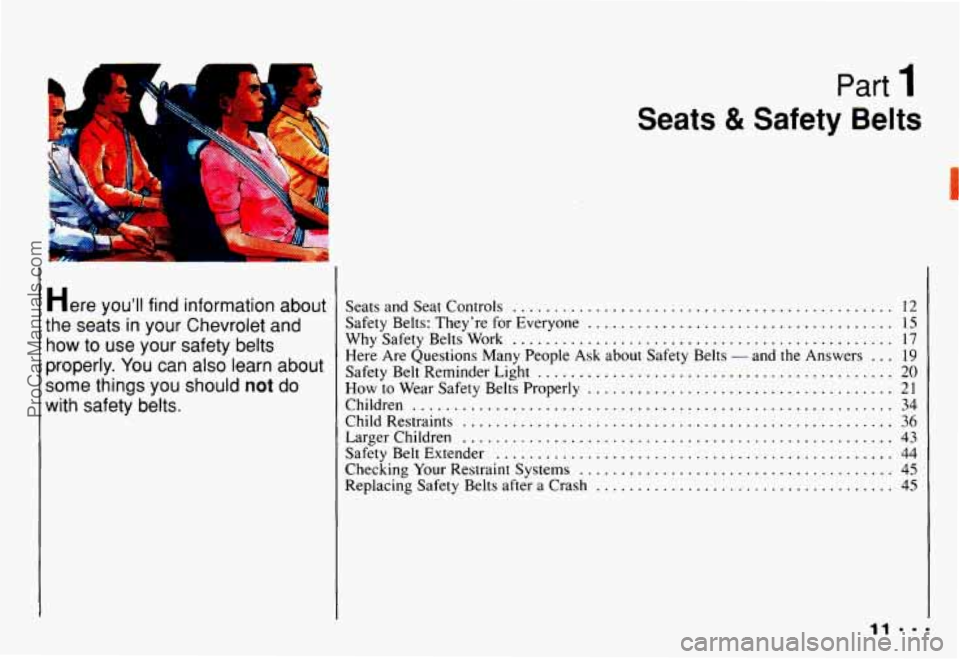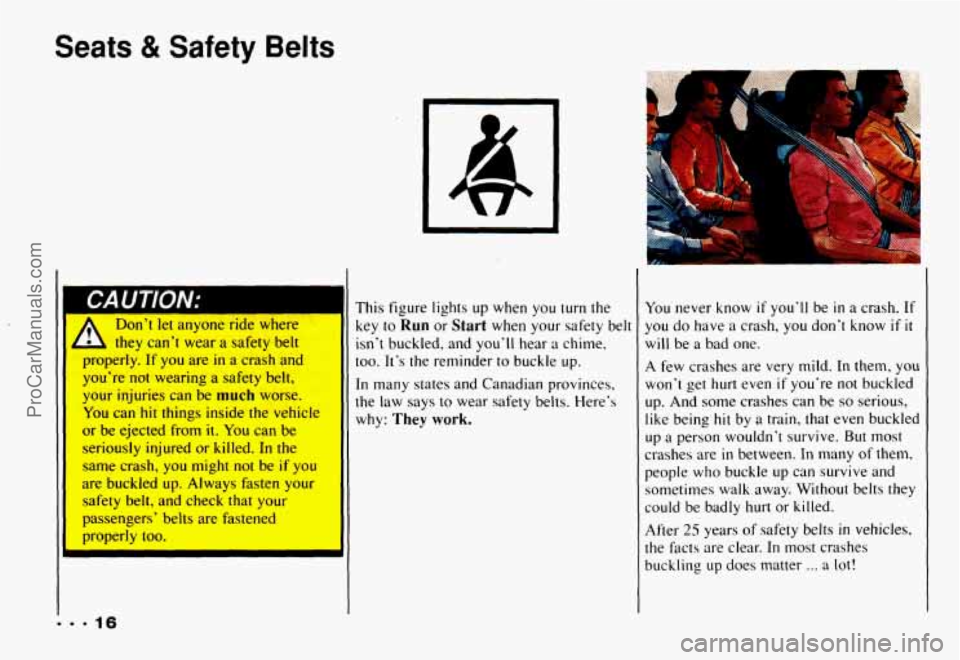Page 3 of 358
1993 Owner’s Manual
Carnaro Table of Contents
Introduction HOW to Use This Manual. - 61
Part I Seats & Safety Belts m 11 I
Part 2 Features & Controls m 47 I
Part 3 Comfort Controls & Audio Systems A09
Part 4 Your Driving and the Road 131
Part 5 Problems on the Road 183
Part 6 Service & Appearance Care 217
Part 7 Maintenance Schedule. . m 285
Part 8 Customer Assistance Information 313
including “Reporting Safety Defects” on page 318.
Part9 Indexm= mm....................... 329
Service Station Information Last Page
Part No. 101 93571 B Second Printing
Printed in U.S.A.
ProCarManuals.com
Page 8 of 358

How to Use This Manual
How to Use This
Manual
Many people read their owner’s manual
from beginning to end when they first
receive their new vehicle. This will help
you learn about the features and controls
for your vehicle. In this manual, you’ll
find that pictures and words work
together to explain things quickly.
Index: A good place to look for what
you need is
the Index in back of the
manual. It’s an alphabetical list of all
that’s
in the manual, and the page
number where you’ll find it.
Parts 1-8: Each part of this manual
begins with a brief list of its contents,
so
you can often find at a glance if a part
contains the information you want.
How to Use This Manual
This part tells you how to use your
manual and includes safety and vehicle
damage warnings and symbols.
Part 1: Seats & Safety Belts
This part tells you how to use your seats
and safety belts properly.
Part 2: Features & Controls
This part explains how to start and
operate your Chevrolet.
Part 3: Comfort Controls & Audio
Systems
This part tells you how to adjust the
ventilation and comfort controls and
how to operate your sound system.
Part 4: Your Driving and the Road
Here you’ll find helpful information and
tips about the road and how to drive
under different conditions.
Part 5: Problems on the Road
This part tells you what to do if you
have a problem while driving, such as a
flat tire or engine overheating.
Part 6: Service & Appearance Care
Here the manual tells you how to keep
your Chevrolet running properly and
looking
good.
Part 7: Maintenance Schedule
This part tells when to perform vehicle
maintenance and what fluids and
lubricants to use.
ProCarManuals.com
Page 15 of 358

Part 1
.
Seats & Safety Belts
I
Here YOU’II find information about
the seats in your Chevrolet and
how to use your safety belts
properly
. You can also learn about
some things you
should not do
with safety belts .
Seats and Seat Controls .............................................. 12
Safety Belts: They’re for Everyone ..................................... 15
Why Safety Belts Work .............................................. 17
Safety Belt Reminder Light ........................................... 20
How to Wear Safety Belts Properly ..................................... 21
Children .......................................................... 34
Child Restraints .................................................... 36
LargerChildren .................................................... 43
Safety Belt Extender ................................................ 44
Checking Your Restraint Systems ...................................... 45
Replacing Safety Belts after a Crash .................................... 45
Here Are Questions Many People Ask about Safety Belts - and the Answers ... 19
ll...
ProCarManuals.com
Page 16 of 358
Seats & Safety Belts
I
1
i
. 12
Seats and Seat Controls
This section tells you about the seats -
how to adjust them, and also about
reclining front seatbacks, seatback latches
and
the folding rear seatback.
Manual Front Seat
Move the lever under the passenger's
front seat to unlock it. Slide the seat to
where you want it. Then release the lever
and
try to move the seat with your body,
to make sure the seat is locked into place.
1
Four- Way Manual Seat
To move the driver's seat forward or
backward, lift the lever under the left
front
of the seat. To tilt the entire seat, lift
the lever under the right front of the seat.
ProCarManuals.com
Page 18 of 358
Seats 8t Safety Belts
II
A
Sitting in a reclined position when your vehicle is in motion can be
- dangerous. Even if you buckle up, your safety belts can’t do their job when
you’re reclined like this.
The shoulder belt can’t
do its job because it won’t be against your body. Instead,
it will be in front of you. In a crash you could go into it, receiving neck or other
injuries.
The lap belt can’t
do its job either. In a crash the belt could go up over your
abdomen. The belt forces would be there, not at your pelvic bones. This could
cause serious internal injuries.
For proper protection when the vehicle is
in motion, have the seatback upright.
Then sit
well back in the seat and wear your safety belt properly.
Front Seatback latches
The front seatbacks fold forward to let
people get into the back seat. To fold a
seatback forward, push
the seatback
toward the rear as
you lift this latch. Then
the seatback will fold forward.
14
ProCarManuals.com
Page 20 of 358

Seats & Safety Belts
I bU u I IUIV.’
n
Don’t let anyone rid6 where
h they can? wear a safety belt
properIy. If YOU are in a crash and
you’re not wearing a safety belt,
your injuries can be much worse.
You can hit things inside the vehicle
or be ejected from it. You can be
seriously injured or killed. In the
same crash, you might not k if you
are buckled up. Always fasten your
safety belt, and check that your
passengers” belts are fastened
properly too.
This figure lights up when you turn the
key
to Run or Start when your safety belt
isn‘t buckled, and you’ll hear a chime,
too.
It’s the reminder to buckle up.
In many states and Canadian provinces,
the law says
to wear safety belts. Mere’s
why:
They work.
You never know if you’ll be in a crash. If
you do have a crash, you don’t know if it
will be a bad one.
A few crashes are very mild. In them, you
won‘t get hurt even if you’re not buckled
up. And some crashes can be
so serious,
like being hit by a train, that even buckled
up
a person wouldn’t survive. But most
crashes are in between. In many
of them,
people
who buckle up can survive and
sometimes walk away. Without belts they
could be badly hurt
or killed.
After
25 years of safety belts in vehicles,
the fxts are clear. In most crashes
buckling
up does matter ... a lot!
ProCarManuals.com
Page 22 of 358
Seats 8t Safety Belts
Put someone on it.
9 9 9 18
Get it up to speed. Then stop the "car."
The rider doesn't stop. The person keeps going until stopped by
something.
In a real vehicle, it could be the
windshield ...
ProCarManuals.com
Page 24 of 358

Seats & Safety Belts
Q: Why don’t they just put in air bags
so people won’t have to wear safety
belts?
Restraint systems, are in some
vehicles today and
will be in more of
them
in the future. But they are
supplemental systems only
- so they
work
with safety belts, not instead of
them. Every “air bag” system ever
offered for sale has required the use of
safety belts. Even
if you’re in a
vehicle that has “air bags,” you still
have to buckle up to get the
most
protection. That’s true not only in
frontal collisions, but especially in
side and other collisions.
A: “Air bags,” or Supplemental Intlatable
---2o
Q: If I’m a good driver, and I never
drive far from home, why should
I
wear safety belts?
A: You may be an excellent driver, but if
you’re in an accident - even one that
isn’t your fault
- you and your
passengers can be hurt. Being
a good
driver doesn’t protect you from things
beyond your control, such
as bad
drivers.
Most accidents occur
within 25 miles
(40 km) of home. And the greatest
number
of serious injuries and deaths
occur at speeds
of less than 40 mph
(65 km/h).
Safety belts are for everyone.
Safety Belt Reminder
Light
When the key is turned to Run or Start,
a light will come on for about eight
seconds to remind people
to fasten their
safety belts. Unless the driver’s safety belt
is buckled, a chime will also sound.
ProCarManuals.com